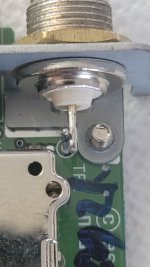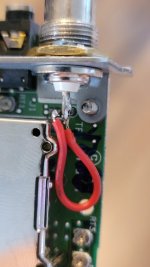I noticed that my bnc connection was loose and also it seemed like the signal would go in and out. So I did a little disassembly and saw the the solder from the bnc to a post on the board was broken.
Got out my soldering equipment and got the old solder off.
I noticed there is a hole in the bnc connection post and I'm wondering if the board post should be put through the hole before I resolder it. I'm assuming it was done correctly at the factory and I should just put it back like I found it but thought I'd check what others thought first. Hopefully pictures clear up any bad explanation.
P. S. The brass nut was undone by me, it was much tighter originally, but still a little loose. Also, my pictures were too big so it was easier for me to send the pics to imgur
Got out my soldering equipment and got the old solder off.
I noticed there is a hole in the bnc connection post and I'm wondering if the board post should be put through the hole before I resolder it. I'm assuming it was done correctly at the factory and I should just put it back like I found it but thought I'd check what others thought first. Hopefully pictures clear up any bad explanation.
P. S. The brass nut was undone by me, it was much tighter originally, but still a little loose. Also, my pictures were too big so it was easier for me to send the pics to imgur



